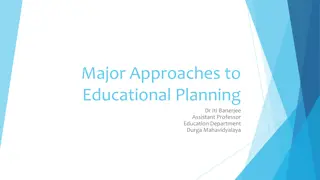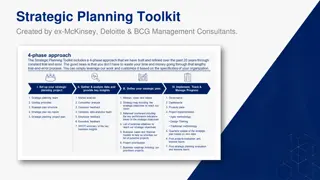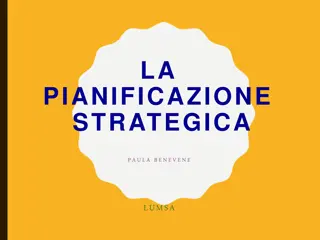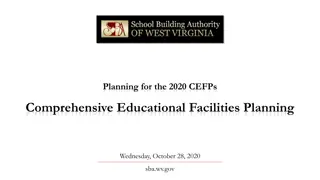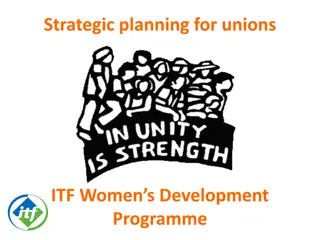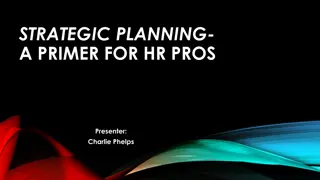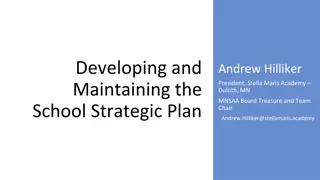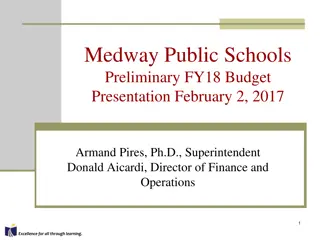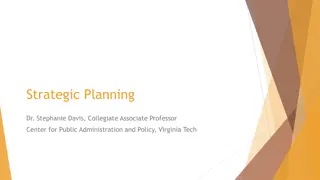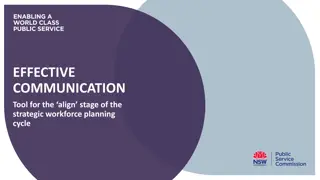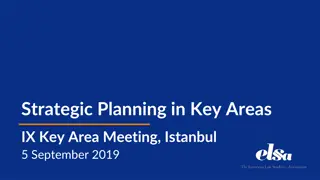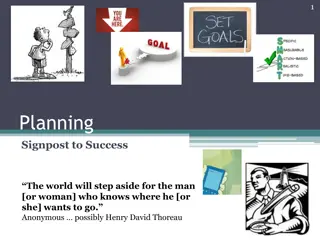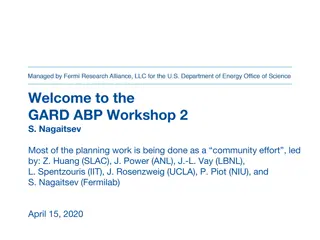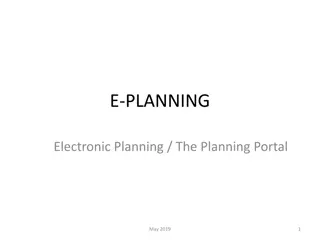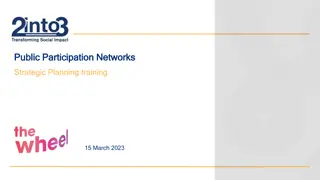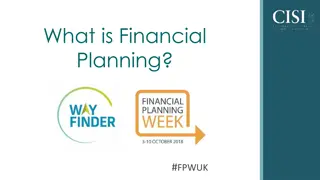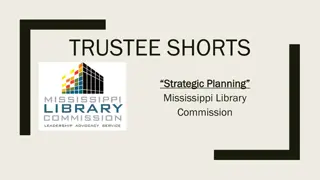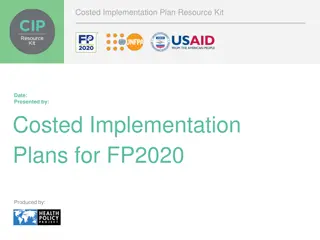Strategic Planning Process for Educational Goals
This document outlines a detailed strategic planning process for educational goals, including steps involved, retreats, brainstorming sessions, faculty voting, and plan integration. Key elements include setting goals, narrowing outcomes, faculty engagement, and final plan endorsement.
Download Presentation

Please find below an Image/Link to download the presentation.
The content on the website is provided AS IS for your information and personal use only. It may not be sold, licensed, or shared on other websites without obtaining consent from the author.If you encounter any issues during the download, it is possible that the publisher has removed the file from their server.
You are allowed to download the files provided on this website for personal or commercial use, subject to the condition that they are used lawfully. All files are the property of their respective owners.
The content on the website is provided AS IS for your information and personal use only. It may not be sold, licensed, or shared on other websites without obtaining consent from the author.
E N D
Presentation Transcript
General Faculty Meeting 7/31/15
STEPS IN STRATEGIC PLAN DESIGN Step Primary People/Groups Involved Hold retreat to brainstorm goals and outcomes Deans, Chairs, Faculty Council, Program Directors Vote to endorse goals and narrow outcomes list Faculty College-wide via Survey Monkey Integrate CEPH and Retreat Goals and generate outcome subcomponents Dean s Group/Faculty Representatives Presentand discuss complete draft Faculty attending College-wide Faculty Meeting Vote to endorse comprehensive plan Faculty College-wide via Survey Monkey
Sept. 12, 2014: Strategic Planning Retreat Brainstormed educational and research goals Narrowed list by faculty representatives vote Combined subgroup lists of possible outcomes associated with top goals November-December, 2014: College-wide Faculty Vote via Survey Monkey Endorsed educational and research goals Voted on preferred outcomes
January, 2015: Service Retreat Preparation Departments completed SWOT analyses HSC drafted patient care goal recommendations Jan. 7thdiscussion by ELC regarding service retreat February 3, 2015: Strategic Planning Retreat Brainstormed service goals Narrowed list by faculty representatives vote
March, 2015: College-wide Faculty Vote via Survey Monkey for Service Goals Voted on preferred service goals June-July, 2015: Integrated CEPH and Retreat Plans Dean s group organized service outcomes Dean s group created final strategic plan draft for faculty review and endorsement Presentation of strategic plan draft at College-wide faculty meeting (7/30/15)
Educational Goals CEPH STRATEGIC RETREAT SUGGESTED DRAFT Provide excellent programs that prepare graduates to address multifaceted health needs Produce well rounded professionals recognized for: critical thinking scientific orientation communication skills Inter-professional collaboration leadership Produce well rounded graduates recognized for: critical thinking scientific orientation communication skills Inter-professional collaboration leadership Leader in evidenced- based teaching and innovative educational methods Become a globally recognized leader for high quality, innovative, evidenced-based academic programming Global recognition for quality of cutting-edge programs
RESEARCH GOALS CEPH STRATEGIC RETREAT SUGGESTED DRAFT Meaningful high-impact research to improve individual, community, and population level health, locally, nationally and globally Address priority health needs by conducting high quality research and disseminating the findings Conduct and disseminate the results of high impact research designed to improve individual, community, and population health An environment that supports effective interdisciplinary collaboration Environment that fosters growth and development at all levels (pre-doc on) Support interdisciplinary collaboration Foster professional growth and development for students and faculty
SERVICE GOALS CEPH STRATEGIC RETREAT SUGGESTED DRAFT Improve patient experience and clinical outcomes College recognized for leadership in shaping policy, practice, and the agenda for the professions Work in an environment where service is valued and rewarded Lead and actively participate in serving our university, our professions, and individuals and communities Ensure exceptional patient service and outcome Demonstrate leadership in shaping policy, practice, and the agenda for the professions Foster a positive work environment in which service is valued and rewarded
Enroll a strong and diverse student body 1. 2. Establish program standards for number of student presentations, publications, and grants 3. Prepare graduates who are competitive in employment markets
1a. Enroll a strong and diverse student body Maintain high standards for admission to undergraduate programs Evaluate graduate admissions criteria (Review grade point average and Graduate Record Exam data of academic programs to determine if acceptance patterns reflect appropriate level of competitiveness); if not, implement recruitment plan over next 5 years to raise admission criteria i. ii.
1a. Enroll a strong and diverse student body iii. Review student attrition data to determine any specific patterns or needs for intervention iv. Identify students to recommend for leadership positions in student organizations each year
1a. Enroll a strong and diverse student body Identify programs with limited diversity and design concrete plan to increase applicant pool and successful enrollments through targeted recruitment v. vi. Continue participation in undergraduate and graduate minority fairs
1b. Establish program standards for number of student presentations, publications, and grants Ensure individual development plan for each PhD student includes annual goals for number and type of presentations, grant writing practice and submission, and research leading to publications (with number of publications expected each year as student develops and as appropriate to the discipline) i.
1c. Prepare graduates who are competitive in employment markets Implement systematic review of employment data and identify areas for potential advising/skills building enhancements i. Evaluate and strengthen current career planning programs in each discipline ii.
1. Recruit and retain outstanding faculty 2. Maintain accreditation at the highest standard awarded 3. Increase the number of training grants 4. Increase faculty engagement with innovative educational methods and technology to improve the student s educational experience
2a. Recruit and retain outstanding faculty Complete pre-eminence hires i. Identify additional faculty hiring needs supporting excellence in teaching and develop recruitment and resource plan /timeline in next five years ii.
2a. Recruit and retain outstanding faculty iii. Design and implement more comprehensive exit interview related to faculty attrition, and review exit interview data to determine any trends/issues to address iv. Review incentive plan components for enhancements potentially impacting retention
2b. Maintain accreditation at the highest standard awarded Ensure review of curriculum on bi-annual basis related to accreditation trends Facilitate faculty participation in state or national organizations involved in influencing or setting curricular policy iii. Review PhD 5-year plans and success in implementing best practice requirements; set course to incorporate any best practices not yet implemented i. ii.
2c. Increase the number of training grants Evaluate collaborative opportunities for reasonable success in acquiring training grants i. Set targeted number for submission of training grants ii.
2d. Increase faculty engagement with innovative educational methods and technology to improve the student s educational experience Complete conversion to CANVAS for each department i. Implement orientation program on blended learning for faculty ii.
2d. Increase faculty engagement with innovative educational methods and technology to improve the student s educational experience iii. Design and implement learning tools and associated trainings for use by faculty in blended learning courses based on recommendations of the Blended Learning Task Force iv. Increase faculty engagement in inter-professional education activities
1. Increase number of peer-reviewed publications with particular attention to journal quality and impact factor 2. Increase external support for research endeavors 3. Generate greater public awareness of research projects and findings (e.g. media attention; presentations, etc.)
1a. Increase number of peer-reviewed publications with particular attention to journal quality and impact factor Evaluate 3-year data of faculty publications by level and discipline i. Set targets for submission to top journals ii. iii. Incorporate publication expectations into annual faculty evaluations
1b. Increase external support for research endeavors Identify grant sources not taking maximal advantage of based on Academic Analytics data i. Map out plan for increasing grant submissions incorporating the above sources as appropriate to faculty expertise ii.
1b. Increase external support for research endeavors iii. Set clear expectations for grant submissions for tenured/tenure track faculty members and identify support needs to facilitate success as principal investigators iv. Evaluate incentives around grant and publication success
1c. Generate greater public awareness of research projects and findings (e.g. media attention; presentations, etc.) Increase number of professional presentations faculty give i. Create public relations clearinghouse to which research findings are systematically linked for potential distribution; take advantage of social media outlets ii.
1c. Generate greater public awareness of research projects and findings (e.g. media attention; presentations, etc.) iii. Identify opportunities and develop public service announcements related to discoveries iv. Develop communication strategy with local community
1. Increase the number of faculty serving as Principal Investigators or Co-Investigators on interdisciplinary team science projects 2. Increase opportunities for community collaboration and implementation of research in community settings 3. Increase co-authorship of publications that reflect interdisciplinary collaboration
2a. Increase the number of faculty serving as Principal Investigators or Co-Investigators on interdisciplinary team science projects Review research areas of pre-eminence hires (i.e. generally and in cancer) to identify specific opportunities for new collaborations i. Determine targeted/prioritized areas to increase cross-disciplinary and cross-college collaborations to accelerate scientific momentum ii.
2a. Increase the number of faculty serving as Principal Investigators or Co-Investigators on interdisciplinary team science projects iii. Ensure junior faculty, in particular, are introduced to potential collaborators from other disciplines; shape this as an expectation as part of culture
2b. Increase opportunities for community collaboration and implementation of research in community settings Invite community stakeholders to annual Research Fair and College Distinguished Speaker series i. As collaborative research priorities are set, incorporate role for community stakeholders as appropriate; evaluate specific partnership opportunities (e.g. Dept. of Health) ii.
2c. Increase co-authorship of publications that reflect interdisciplinary collaboration Set expectations for co-authored publications as part of collaborative research project roll- out i. Include faculty expectations for collaborative production during annual evaluations ii.
1. Increase percent of junior faculty who achieve tenure, promotion, advancement, and professional recognitions 2. Ensure salaries meet or exceed national (peer) medians for faculty and students 3. Ensure each faculty and student has an individual professional development plan
3a. Increase percent of junior faculty who achieve tenure, promotion, advancement, and professional recognitions Streamline annual evaluation process/design template to focus on progression and goals related to tenure and promotion i. Map Tenure and Promotion criteria to annual evaluation goals prior to finalizing letters ii.
3a. Increase percent of junior faculty who achieve tenure, promotion, advancement, and professional recognitions iii. Ensure timely 3-year reviews and create concrete response plan in any weaker areas, including meeting with dean and chair within one month of review to discuss steps to strengthen packet
3b. Ensure salaries meet or exceed national (peer) medians for faculty and students Conduct comparison of salaries to available national data i. Develop sequential plan to address identified areas of salary compression based on college priorities ii.
3c. Ensure each faculty and student has an individual professional development plan Review components of plan against expected standards of progression/promotion to ensure complete i. Maintain tracking system to ensure plans are completed, discussed, and signed ii.
1. Ensure clinical procedures facilitate maximal clinical outcomes 2. Ensure strong patient satisfaction ratings (4-5 on 5-point scale) 3. Increase visibility/branding to foster enhanced reputation of clinical programs 4. Leverage technology to enhance timely and effective service delivery and outcomes
1a. Ensure clinical procedures facilitate maximal clinical outcomes Sentinel event occurrence <1% i. 90% or greater compliance with all Joint Commission standards ii.
1b. Ensure strong patient satisfaction ratings (4-5 on 5-point scale) Identify and implement patient satisfaction survey with systematic review i.
1c. Increase visibility/branding to foster enhanced reputation of clinical programs Identify services with growth potential i. Create targeted marketing plan for clinical programs, with particular attention to niche markets emphasizing unique expertise ii.
1d. Leverage technology to enhance timely and effective service delivery and outcomes Review EPIC/other data systems for enhancements related to timely documentation i. Increase efficiency in scheduling systems ii.
1d. Leverage technology to enhance timely and effective service delivery and outcomes iii. Manage patient backlogs iv. Organize data available to establish system for monitoring and predicting clinical service functions and needs
1. Foster faculty leadership contributions to professional and governmental agencies and associations 2. Build partnerships with community organizations to promote health 3. Provide educational programs that meet workforce development needs
2a. Foster faculty leadership contributions to professional and governmental agencies and associations Identify faculty to nominate for strategically selected leadership positions i. Groom younger faculty for future national roles by facilitating relevant committee membership ii.
2a. Foster faculty leadership contributions to professional and governmental agencies and associations iii. Continue targeting high impact University of Florida committees affecting college for nomination for committee openings (ongoing from previous plan)
2b. Build partnerships with community organizations to promote health Engage student organizations to identify college-wide community service initiative (ongoing from previous plan) i. Expand the reach of HealthStreet ii.
2c. Provide educational programs that meet workforce development needs Complete implementation of communication sciences and disorders certificate i. Spearhead development of doctor of occupational therapy program ii.
2c. Provide educational programs that meet workforce development needs iii. Spearhead approval process for undergraduate public health degree proposal iv. Complete leadership transition for Forensic Vocational Rehabilitation, Geriatric Care Management, and Medicaid certificate programs and evaluate continuing need
1. Enhance opportunities for recognition of faculty and staff who provide outstanding or broad-based service


